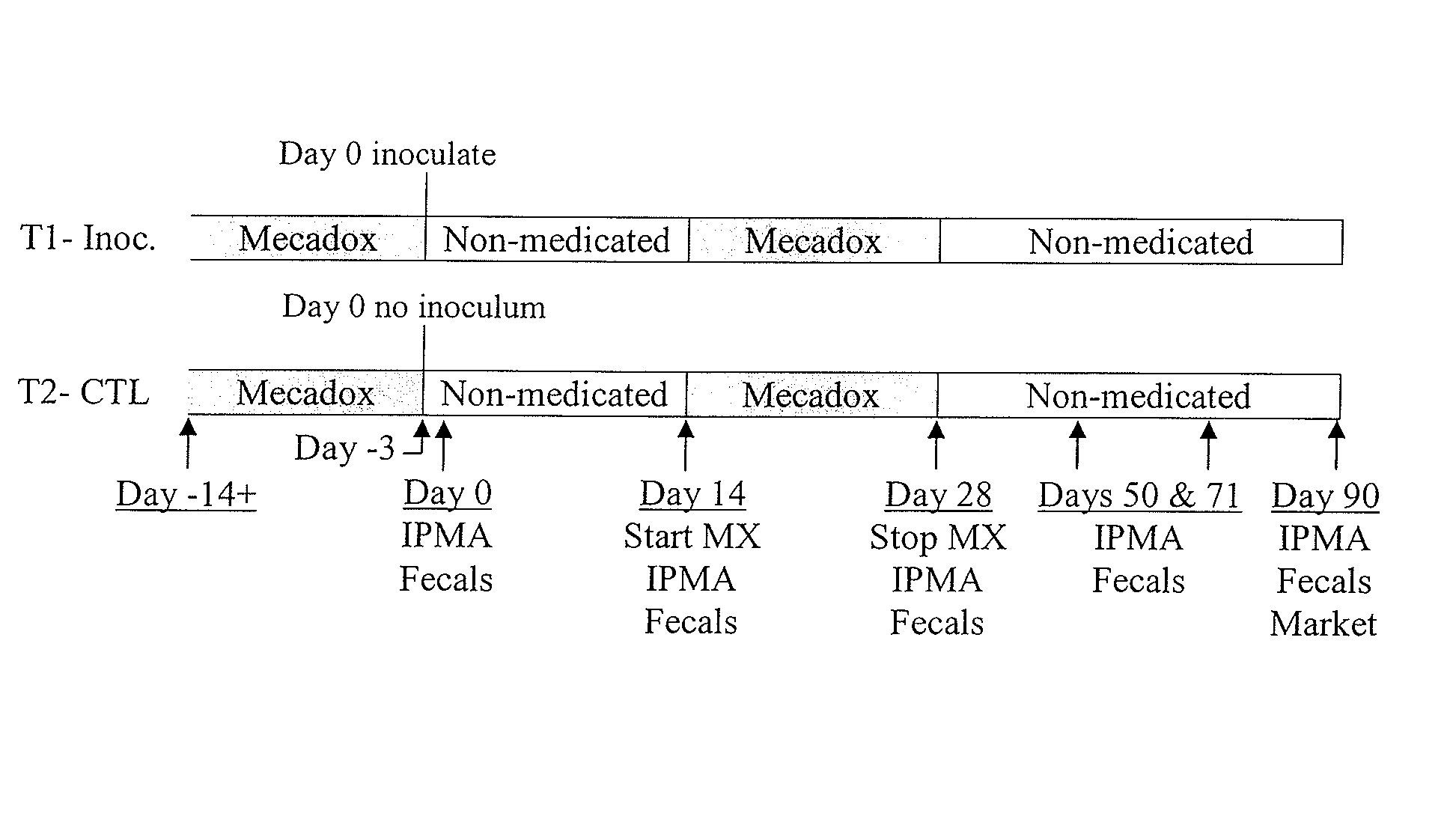Vaccination for Lawsonia intracellularis
a vaccine and intracellular technology, applied in the field of vaccines for lawsonia intracellularis, can solve the problems of high morbidity and mortality, loose stool, and bloody stool
- Summary
- Abstract
- Description
- Claims
- Application Information
AI Technical Summary
Benefits of technology
Problems solved by technology
Method used
Image
Examples
example 1
Preparation of Challenge Inoculum
[0076]Challenge inoculum was prepared from mucosa harvested from the intestines of pigs having gross lesions consistent with PPE. To obtain the homogenate, mucosa was scraped from small intestines affected with moderate to severe PIA and (or) necrotic PPE lesions, and suspended at a 1:1 ratio in sucrose-phosphate-glutamate (SPG) buffer, pH 7.0, which contained sucrose (0.218 mol per L), monobasic potassium phosphate (KH2PO4; 0.0038 mol per L), dipotassium phosphate (K2HPO4; 0.0072 mol per L), and L-glutamic acid (0.0047 mol per L). The source for all reagents was Sigma (St Louis, Mo.). The mucosal suspension was homogenized in a blender to obtain an uniform homogenized suspension. Homogenates were stored at −70° C. until used, and thawed and stored on ice on days of use. Samples were submitted on ice to the Department of Veterinary Pathobiology, University of Minnesota, for enumeration of L. intracellularis by immunoperoxidase staining and quantitati...
example 2
Using a Controlled Exposure to Lawsonia intracellularis with Carbadox to Stimulate Immune Response in Pigs
[0077]Proliferative enteropathy (also known as PE or ileitis) caused by Lawsonia intracellularis is a common infectious disease of swine worldwide. Field studies and experience have demonstrated immunological protection from L. intracellularis offers benefits to both growth performance and control of clinical and sub-clinical PE (Kolb and Sick, “Summary of field trials implementing Enterisol® Ileitis against ileitis,”Proc. American Association of Swine Veterinarians Annual Meeting. Orlando, Fla. 2003:243-244). An immune response to L. intracellularis has been shown to develop in pigs following natural and experimental infections and after vaccination with avirulent live L. intracellularis organisms (Collins et al., “The Development of Immunity to Lawsonia intracellularis in weaned pigs,”Proc. of the 7th Biennial Conference of the Australasian Pig Science Assoc., Adelaide, Austra...
example 3
Lawsonia intracellularis (Ileitis) Challenge Experiment
[0095]This example will compare the clinical, pathological, laboratory, and performance parameters in “controlled immunity” pigs vaccinated with ileitis autogenous vaccine followed by either MECADOX (carbadox) 25 g / ton (also referred to herein as “Mec 25”) or MECADOX (carbadox) 50 g / ton (also referred to herein as “Mec 50”) or pigs vaccinated with Enterisol Ileitis® all followed by a heavy Lawsonia intracellularis (Li) disease challenge four weeks after vaccination.
[0096]All pigs in T1, T2, T3, and T4 will be humanely euthanized on Day 52, 24 days after the Li oral gavage. Clinical parameters to be measured are Fecal Scores (0-3), Abdominal Appearance Score (0-2), and Pig Demeanor Score (0-2). Ileitis pathology to be measured includes gross PPE lesion scores, lesion length and IHC scores (0-4). Laboratory analysis on serum IPMA, and fecal PCR will be completed at specific time points throughout the study. Performance parameters ...
PUM
| Property | Measurement | Unit |
|---|---|---|
| time | aaaaa | aaaaa |
| time | aaaaa | aaaaa |
| pH | aaaaa | aaaaa |
Abstract
Description
Claims
Application Information
 Login to View More
Login to View More - R&D
- Intellectual Property
- Life Sciences
- Materials
- Tech Scout
- Unparalleled Data Quality
- Higher Quality Content
- 60% Fewer Hallucinations
Browse by: Latest US Patents, China's latest patents, Technical Efficacy Thesaurus, Application Domain, Technology Topic, Popular Technical Reports.
© 2025 PatSnap. All rights reserved.Legal|Privacy policy|Modern Slavery Act Transparency Statement|Sitemap|About US| Contact US: help@patsnap.com

